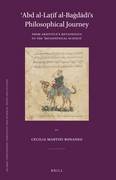Details
Now Available: ʿAbd al-Laṭīf al-Baġdādī’s Philosophical Journey by Cecilia Martini Bonadeo
ʿAbd al-Laṭīf al-Baġdādī’s Philosophical Journey. From Aristotle’s Metaphysics to the ‘Metaphysical Science’ by Cecilia Martini BonadeoCecilia Martini Bonadeo, ʿAbd al-Laṭīf al-Baġdādī’s Philosophical Journey. From Aristotle’s Metaphysics to the ‘Metaphysical Science’, Brill 2013, coll. Islamic Philosophy, Theology and Science. Texts and Studies 88 (xii, p. 378).
Abd al-Laṭīf al-Baġdādī’s Philosophical Journey: From Aristotle’s Metaphysics to the ‘Metaphysical Science’ is devoted to the Arabic reception of Greek philosophy and metaphysics in the work of Muwaffaq al-Dīn Muḥammad ʿAbd al-Laṭīf ibn Yūsuf al-Baġdādī (1162–November 9, 1231). Its focus is al-Baġdādī's Book on the Science of Metaphysics (Kitāb fī ‘ilm mā ba‘d al-ṭabī‘a), whose acquaintance with crucial Greek metaphysical doctrines is discussed.
Cecilia Martini Bonadeo presents first the framework within which al-Baġdādī’s metaphysical work should be considered, through a survey of the translations, commentaries, and the works of the Hellenizing Arabs which had access to Aristotle’s Metaphysics. An overview of the Greek tradition of this Aristotelian treatise is provided, which highlights the making of the Metaphysics as a unitary treatise out of a series of writings devoted by Aristotle to various topics. An overview of the Greek commentaries helps to follow the history of the Metaphysics in the Greek world. Then she considers the first stage of the translation and reception of the Metaphysics in the Arabic-speaking world, paying special attention to the translators, to al-Kindī (795–865) and his treatise On First Philosophy, together with some of his metaphysical and cosmological writings. Ṯābit ibn Qurra (836–901) and his Concise Exposition of Lambda is also discussed. She then deals with the assimilation of the text of the Metaphysics in the Peripatetic circle of Baghdad during the tenth century, through an analysis of some writings by al-Fārābī (870–951), and the commentary on Alpha Elatton by Yaḥyā ibn ʿAdī (893–974). Finally, she focuses on Avicenna’s metaphysical training, his own contribution to metaphysics, and the different reactions to his thought in the post-Avicennian philosophical tradition in the East of the Muslim world.
In the second chapter, Cecilia Martini Bonadeo presents ʿAbd al-Laṭīf al-Baġdādī’s biography as given by Ibn Abī Uṣaybiʿa. To this source of information another is added: the autobiographic report of al-Baġdādī’s stay in Egypt. This helps framing him in a historical and cultural context which is still little investigated. She then examines al-Baġdādī’s Book of the Two Pieces of Advice, from which the autobiography is taken. This writing offers al-Baġdādī’s intellectual biography, his educational itinerary, the library he had at his disposal, and his cultural attitude with regard to the "Ancients". An analysis of al-Baġdādī’s encyclopaedic works follows: these are described following the testimony of the manuscript Bursa, Hüseyin Çelebi, 823, which contains various of his treatises. A number of tables allows Cecilia Martini Bonadeo to compare the ancient lists of al-Baġdādī’s works.
In the third chapter, after a presentation of the two manuscripts which have preserved al-Baġdādī’s metaphysical work, Cecilia Martini Bonadeo discusses the coherence of the accounts in the Book on the Science of Metaphysics from the point of view of its use of sources and from that of its relationship with the metaphysical project elaborated, at the beginnings of the falsafa, by al-Kindī in his On First Philosophy. Then, in the third section, she shows the correspondence of al-Baġdādī’s work with the main framework of metaphysical science as presented by al-Fārābī in his Enumeration of the Sciences. It appears that, over the course of little more than four centuries, a metaphysical discipline was established in the Muslim East which received its ultimate form as a synthesis of the metaphysical doctrines of Aristotle, Alexander of Aphrodisias, Themistius, Plotinus, Proclus, al-Kindī and al-Fārābī.
The Book on the Science of Metaphysics is surely a testimony of the indirect tradition of Aristotle’s Metaphysics, and as such it has been considered in past scholarship. However, it counts also as a sort of textbook, whose object is no longer an authoritative text handed down from the past - Aristotle's Metaphysics - but a discipline. This makes the difference between the history of the science of metaphysics after Avicenna in Muslim East from the developments of the falsafa in al-Andalus, dominated by the figure of Averroes and his long commentaries. Averroes imposed a return to the study of Aristotle’s works in Arabic translation, and to the doctrinal commentary placed between the lemmata of the text. ʿAbd al-Laṭīf al-Baġdādī’s own Aristotle is indeed a “virtual Aristotle” (Endress), created by the falsafa in the course of five centuries. He is that "Aristotle" whose Peripatos ʿAbd al-Laṭīf believed he had seen in the remains of the red granite columns appearing out of the sea on the beach of Alexandria.
< Mission to Teheran, by Marco Di Branco.




